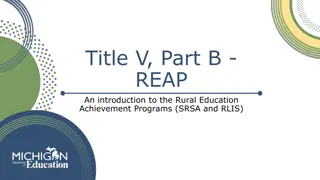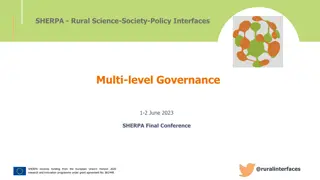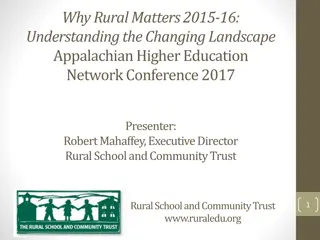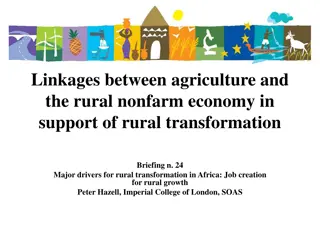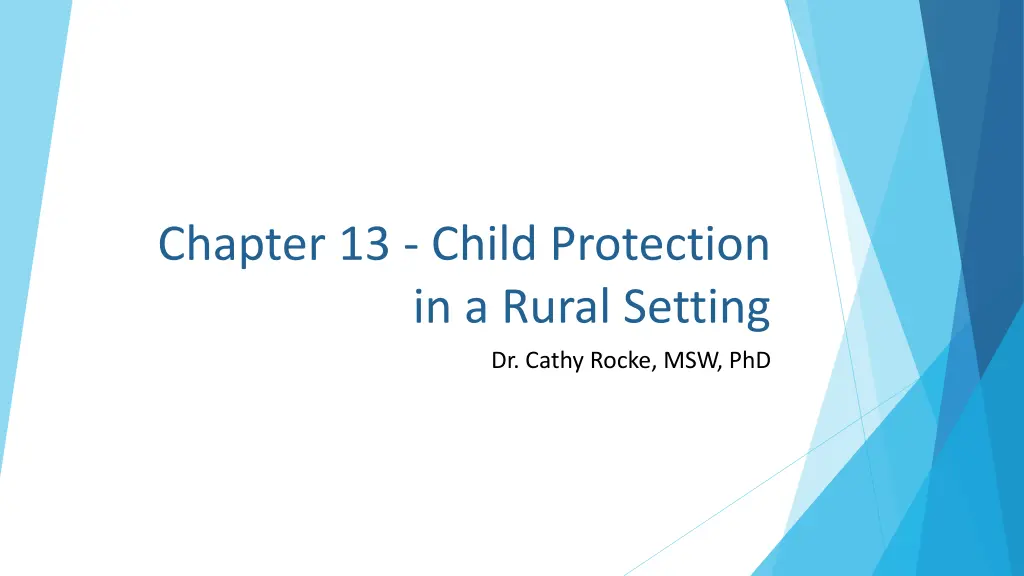
Child Protection Services in Canadian Rural Settings
Explore the unique challenges and considerations involved in providing child protection services in rural Canada, including historical context, social work practices, and ethical considerations. Learn about the development of child welfare services and the role of rural social workers in ensuring the safety and well-being of children and youth.
Download Presentation

Please find below an Image/Link to download the presentation.
The content on the website is provided AS IS for your information and personal use only. It may not be sold, licensed, or shared on other websites without obtaining consent from the author. If you encounter any issues during the download, it is possible that the publisher has removed the file from their server.
You are allowed to download the files provided on this website for personal or commercial use, subject to the condition that they are used lawfully. All files are the property of their respective owners.
The content on the website is provided AS IS for your information and personal use only. It may not be sold, licensed, or shared on other websites without obtaining consent from the author.
E N D
Presentation Transcript
Chapter 13 - Child Protection in a Rural Setting Dr. Cathy Rocke, MSW, PhD
Introduction This chapter will discuss: The unique aspects of providing mandated child protection services in a Canadian rural setting. The development and current state of child welfare in Canada will be presented with specific reference to child welfare services in rural Canada. A review of rural social work practice models and the characteristics of effective rural social workers will be explored. The policy, practice and ethical considerations of child protection within a Canadian rural setting will be presented, drawing on the author s experiences working in a rural community.
Learning Objectives By the end of this chapter you will: Describe the theories of rural social work practice. Describe the history of child welfare services in Canada. Explain the principles of effective child protection practice and how these principles have unique aspects in a rural setting. Discuss how your own values may help or hinder your ability as a child protection worker in a rural setting.
Practice Area and/or the Population of Focus In a Canadian context, rural rates of police-reported violence against children and youth was nearly twice as high compared to urban settings (Burczycka, 2018). Historically, child protection services in rural areas were often left to volunteer community groups or churches. Most child welfare policies are developed with an urban lens and reflect little understanding of the rural communities (Delaney & Brownlee, 2009). Riebschelger and Pierce (2018) add that child welfare workers should have an understanding of the historical context of rural communities they reside in, many of which were founded on agriculture and extraction economies.
Social Work in Rural Settings: Practice Context Rural communities often have limited specialized resources compared to more urban settings; rural social workers need to adopt a generalist practice approach that includes providing a variety of supports, whether it be basic life skills, counselling for mental health concerns, or advocacy for specialized housing (Schmidt, 2021). The literature suggests that due to the complexities of issues faced by rural and northern communities, there are higher expectations for social workers not only to fill multiple roles, but also to utilize various practice models to ensure they are meeting the needs of clients and communities.
Rural Child Protection: Practice Models Daley (2021) advocates for a generalist model of rural social work that draws on several theoretical perspectives and practice models. Strengths Perspective / Problem Solving Model Can be challenging as child protection worker needs to balance with the mandate for child safety. Relational Approach de Boer & Coady (2001) cite the need for the soft, mindful and judicious use of power .
Rural Child Protection: Practice Models Strength Based Child Protection Oliver (2017) model for child protection that is rooted in strength- based perspectives calls for workers to be firm, fair and friendly in their practice. Develop skills that balance collaborative approaches and the constructive use of power. Cultural Humility Moves beyond the concept of cultural competence to developing self-awareness, respectful attitude and openness to multiple perspectives (Ortega & Faller, 2011)
Rural Child Protection: Beyond an Individual Focus Child protection systems are largely focused on the individual. Ongoing need for child protection services to widen the lens to the systemic conditions that contribute to child risk at the familial, community and societal level. Imperative that child protection workers are informed by critical perspectives (e.g., feminism, anti-oppressive practices) especially with marginalized populations who are over-represented within the child protection system.
Overview of Policy and Service Delivery Issues Ethical considerations of child protection Daley (2021) highlights the most common ethical dilemmas to face rural social workers are dual relationships, working in a fishbowl, and confidentiality. Lonne et al. (2016) maintains that ethical dilemmas in child protection are linked to client vulnerability, unequal power relationships and the centrality of relationship in effective ethical practice (p. 4). Barsky (2019) identifies ethical dilemmas that involve value conflicts rooted in religious beliefs as particularly challenging.
Conclusion Providing child protection in a rural setting compounds the challenges of the work; however, when workers are informed by relational approaches that integrate strengths-based solutions, problem solving models, and critical perspectives it is possible for child protection workers to be effective. The work of child protection is not for the faint of heart, but when done well, and when engagement and supports are offered so that families and children can thrive, it can be a rewarding social work career.
References Barsky, A. E. (2019). Ethics and values in social work: An integrated approach for a comprehensive curriculum (2nd ed.). Oxford University Press. Burczycka, M. (2018). Police-reported violence happens between intimate partners. Statistics Canada. https://www150.statcan.gc.ca/n1/pub/85-002- x/2019001/article/00018/02-eng.htm Daley, M. R. (2021). Rural social work in the 21st century: Serving individuals, families, and communities in the countryside (2nd ed.). Oxford University Press. de Boer, C., & Coady, N. (2007). Good helping relationships in child welfare: Learning from stories of success. Child and Family Social Work, 12(1), 32-42. Delaney, R. & Brownlee, K. (2009). Understanding ethics in rural and northern practice. In R. Delaney & K. Brownlee, K. (Eds.), Northern and rural social work: A Canadian perspective, (pp. 109-129). Centre for Northern Studies. Lonne, B., Harries, M., Featherstone, B., & Gray, M. (2016). Working ethically in child protection. Routledge.
References Oliver, C. (2017). Strengths-based child protection: Firm, fair, and friendly. University of Toronto Press. Ortega, R.M. & Faller, K.C. (2011). Training child welfare workers from an intersectional cultural humility perspective: A paradigm shift. Child Welfare, 90(5), 27-49. Riebschleger, J., & Pierce, B. (2018). Rural child welfare practice. In J. Riebschleger & B. J. Pierce, (Eds.), Rural child welfare practice: Stories from the Field (pp. 1-21). Oxford University Press. Saleebey, D. (2012). The strengths perspective in social work practice (6th ed.). Pearson Education Inc. Schmidt, G. (2021). Culture and resource scarcity: Social work practice in Canada s remote communities. In A. Opa i (Ed.), Practicing social work in deprived communities: competencies, methods, and techniques (pp. 209-221). Springer International Publishing.
















